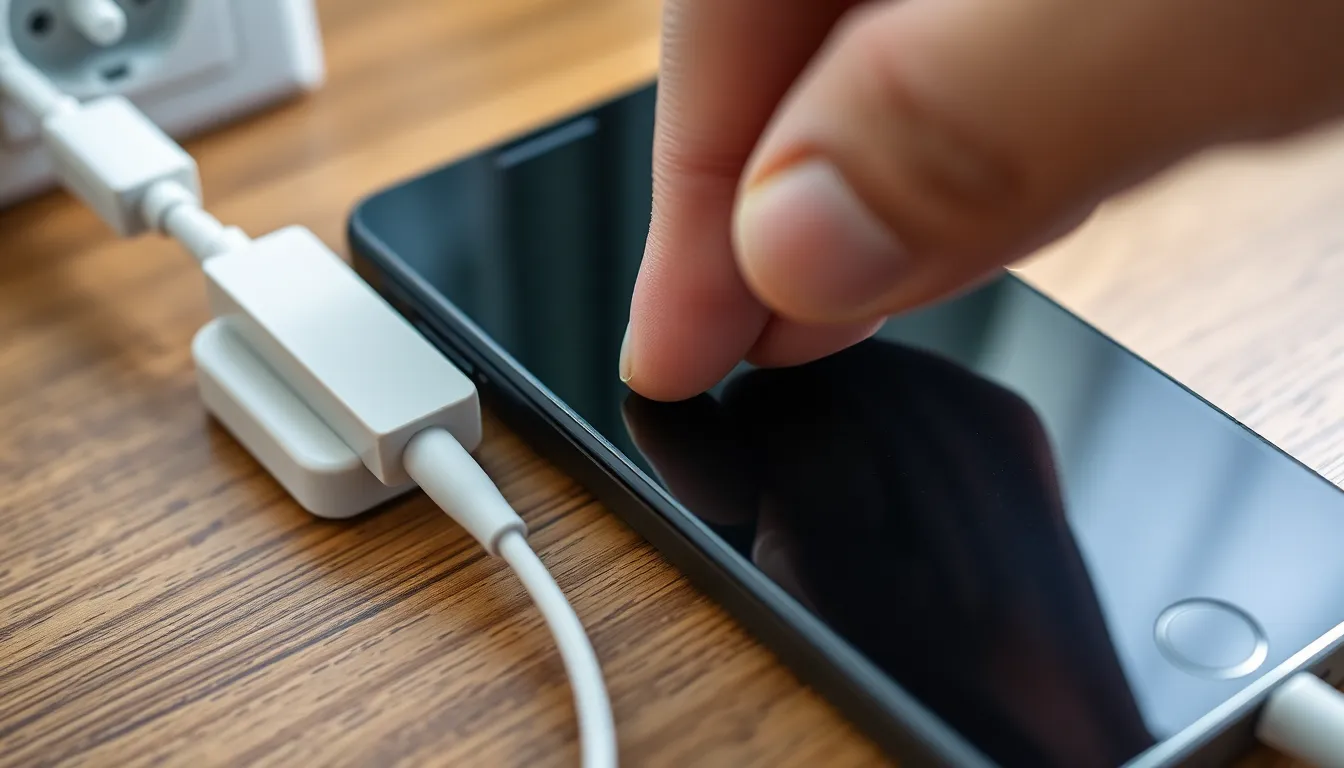There’s nothing quite like the sinking feeling of plugging in an iPhone only to watch it stubbornly refuse to charge. It’s like your phone’s throwing a tantrum right when you need it most. Is it a case of low battery drama, or is there something more sinister at play?
Table of Contents
ToggleCommon Charging Issues
Charging problems can stem from various sources. Identifying these issues helps resolve the frustration of a non-charging iPhone.
Dirt and Debris in Charging Port
Dirt and debris can accumulate in the charging port, causing connection problems. Inspect the port for lint or dirt. Using a flashlight can help spot the debris. Gently clean the port with a soft brush or a toothpick. Ensure devices are powered off before cleaning to avoid damage. Regular inspection and cleaning can prevent charging interruptions.
Faulty Charging Cable
A faulty charging cable can lead to charging issues. Inspect the cable for frays, kinks, or exposed wires. Testing with another cable can determine if the original cable is the problem. Quality matters; always use genuine Apple cables or certified alternatives. Cables worn out from daily use can fail unexpectedly, leading to charging frustrations.
Troubleshooting Steps

Identifying the root cause of an iPhone not charging involves several troubleshooting steps. These actions can reveal whether the issue lies with the device, the accessories, or the power source.
Check the Power Source
Ensure the power outlet is functioning properly. Try plugging the charger into a different outlet to rule out power supply issues. If using a power strip, plug the device directly into the wall socket. An adapter can also be tested to determine if it’s the source of the problem. Devices connected to a USB port on computers might not provide sufficient power; direct wall outlet connections often offer better results. Charge another device with the same outlet to further confirm its reliability.
Inspect the Charging Cable
Examine the charging cable for any signs of wear or damage. Frayed wires, kinks, or exposed sections could prevent charging. Using a genuine or certified cable mitigates the risk of compatibility issues. Trying a different charging cable can also confirm if the original is functional. Cable condition impacts charging efficiency; replacing a faulty cable often resolves charging problems and ensures reliable connectivity.
Clean the Charging Port
Inspect the charging port for dirt or debris accumulation. A clean port maintains good connection quality; even small particles can disrupt charging. Utilize a soft brush or a toothpick to gently remove any dirt without risking damage to the port. Regular cleaning promotes consistent performance and prevents build-up over time. If dirt continues to be a problem, consider scheduling professional cleaning to ensure optimal functionality.
Possible Hardware Problems
Hardware issues often cause an iPhone to stop charging. Identifying these problems helps in troubleshooting the device effectively.
Battery Health
Battery health plays a critical role in charging issues. Aging batteries lose their ability to hold a charge. Over time, factors like charge cycles and temperature fluctuations impact performance. Checking battery status in settings provides insights into health. If the battery health reads below 80%, replacement may be necessary. Regular maintenance and calibration can improve longevity, but a severely degraded battery won’t charge effectively.
Charging Port Damage
Charging port damage frequently disrupts charging functions. Accumulated dust, lint, or debris can block the port and prevent connections. Inspecting the charging port visually helps identify significant build-up or foreign objects. Using a soft brush can effectively clean the port. Additionally, physical damage might occur from frequent insertion and removal of the charger. If the port appears bent or loose, professional repair might be essential. A functional charging port ensures a reliable connection to power sources.
Software Considerations
Software issues can impact an iPhone’s ability to charge correctly. Addressing these involves updating the operating system and resetting settings.
Update iOS
Keeping iOS updated is crucial for optimal functionality. Apple frequently releases updates that include bug fixes and performance enhancements. Users experiencing charging problems should navigate to Settings, then tap General and Software Update to check for available updates. Installing the latest version can resolve software bugs that prevent charging. Regular updates can ensure compatibility with charging accessories as well.
Reset Settings
Resetting settings can often help resolve charging issues. Users can do this by going to Settings, selecting General, then Reset. Choosing Reset All Settings restores settings to their defaults without erasing data. This process eliminates any misconfigurations that might hinder charging. However, it’s important to note that users may need to re-enter Wi-Fi passwords and adjust preferences afterward.
An iPhone that won’t charge can be a source of frustration but understanding the potential causes can lead to effective solutions. From checking for dirt in the charging port to inspecting the cable for damage, a few simple troubleshooting steps can often resolve the issue.
Regular maintenance is key to ensuring the device remains in optimal condition. Keeping the software updated and monitoring battery health can prevent future charging problems. If all else fails and the issue persists, seeking professional assistance may be necessary to address any underlying hardware concerns. Taking these proactive measures can help users enjoy a hassle-free charging experience.



